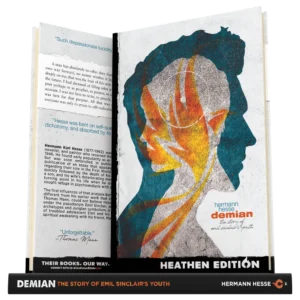No products in the cart.

The Sandman
Heathen Short #14
Author
E.T.A. Hoffmann
Translator
John Oxenford
First Edition
1816 / 1844
Heathen Edition
2025
Refreshed
Pages
48
Heathen Genera
Existentialicious
ISBN
979-8-90075-014-9
This answer of my mother’s did not satisfy me — nay, in my childish mind the thought soon matured itself that she only denied the existence of the Sandman to hinder us from being terrified at him. Certainly I always heard him coming up the stairs. Full of curiosity to hear more of this Sandman, and his particular connection with children, I at last asked the old woman who tended my youngest sister what sort of man he was.
“Eh, Natty,” said she, “do you not know that yet? He is a wicked man, who comes to children when they will not go to bed, and throws a handful of sand into their eyes, so that they start out bleeding from their heads. These eyes he puts in a bag and carries them to the half-moon to feed his own children, who sit in the nest up yonder, and have crooked beaks like owls with which they may pick up the eyes of the naughty human children.”
A most frightful image of the cruel Sandman was horribly depicted in my mind, and when in the evening I heard the noise on the stairs, I trembled with agony and alarm. My mother could get nothing out of me, but the cry of “The Sandman, the Sandman!”
Ernst Theodor Amadeus Hoffmann (1776–1822) was a German Romantic author of fantasy and Gothic horror, as well as a jurist, composer, music critic, and artist. From 1816 to 1817, he published Night Pieces, a collection of eight stories in two volumes. Largely ignored upon release, several tales later drew significant analysis, with “The Sandman” emerging as Hoffmann’s most enduring work. A delirious tale of shattered vision and spiritual dismemberment, the uncanny here is no mere trick of perception — it is the collapse of reality itself. Nathaniel, a doomed romantic gripped by childhood trauma, is haunted by Coppelius, a spectral optician whose instruments of precision conceal a deeper violence. Eyes are plucked, souls distorted, and love reduced to clockwork. At the story’s center stands Olympia — silent, radiant, and impossibly still. “The Sandman” is a fever dream of Enlightenment gone sour, where the boundaries between soul and mechanism, memory and madness, blur beyond recognition. It mocks the rational mind and exalts the terror of childhood fears made incarnate.
Test Your Might
Available on backorder
Arriving Soon-ish!
OTHER RETAILERS
Rate & Shelve It
"The Sandman" is a carefully structured study of developing insanity.
E.F. Bleiler
Supernatural Fiction Writers
Heathenry
Contents
Praise
Details
Heathenry
Arriving Soon-ish! Available NOW for pre-order (backorder) — expected to ship mid to late December.
Contents
Heathenry: Thoughts on the Text
“The Sandman“
“The Sandman“
Praise
“E.T.A. Hoffmann’s fantastic burlesque and profound poetic power have conquered the world.” —The New York Times Book Review
“‘The Sandman’ is a carefully structured study of developing insanity that reveals Hoffmann’s deep interest in psychology.” —E.F. Bleiler, Supernatural Fiction Writers
“Hoffmann’s figures are, to him at least, absolutely real . . . In his stories he hovers always on the boundary between real and the supernatural, crossing and recrossing at will . . . one realm was as real to him as the other.” —Palmer Cobb, “Poe and Hoffmann”
“‘The Sandman’ is the prime object of analysis in Freud’s most important discussion of the fantastic, The Uncanny (1919).” —Eric S. Rabkin, Masterpieces of the Imaginative Mind
“Hoffmann was profoundly interested in the philosophers who were forebears of Jungian thought — Kant, Schelling, and G.H. von Schubert, to name the most important . . . Like Schelling and Schubert, Hoffmann believed that the unconscious was a person’s link to cosmic forces, if only her or she could understand its language.” —Joseph Andriano, Our Ladies of Darkness
“A story like ‘The Sandman’ is true, it gives literary shape to insights which cannot be conveyed in any way less grotesque, absurd, and uncanny.” —S.S. Prawer, Hoffmann’s Uncanny Guest
“E.T.A. Hoffmann, it will by now have been noticed, is by any standards a key figure in the development of the literary fantastic.” —Neil Cornwell, The Literary Fantastic
“‘The Sandman’ brings to the fore the power of vision . . . and deserve[s] to be better placed in the critical history of science fiction.” —Martin Willis, Mesmerists, Monsters, and Machines
“Hoffmann’s writing nearly always creates a sense of boundaries breaking down, of spiritual vertigo.” —Michael Dirda, Classics for Pleasure
Details
The Sandman
Heathen Short #14Published: December 2025
Format: Paperback
Interior: Black & White on Cream Paper
Pages: 50 (+2 POD)
Language: English
Annotations: xx Footnotes
Illustrations: 4
The Heathen Newsletter
Want to be kept in the loop about new Heathen Editions, receive discounts and random cat photos, and unwillingly partake in other tomfoolery? Subscribe to our newsletter! We promise we won’t harass you – much. Also, we require your first name so that we can personalize your emails. ❤️
@heatheneditions #heathenedition
Copyright © 2025 Heathen Creative, LLC. All rights reserved.




